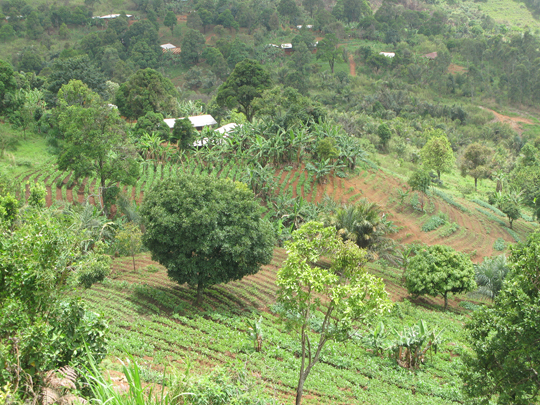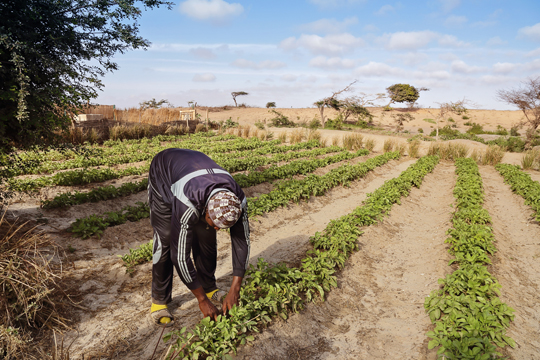Fighting Impacts of Climate Change in Africa
Freiburg, May 07, 2019
Signs of climate change are already apparent in Africa’s southern countries. Dr. Jonathan Sheppard, Dr. Christopher Morhart, and Prof. Dr. Hans-Peter Kahle of the Chair of Forest Growth and Dendroecology of the University of Freiburg are investigating solutions that will shield local agriculture against the effects of climate change. They would also like their work to contribute to sustainable development of these countries.
 Agroforestry combines forestry and arable farming on one piece of land. Photo: Mark Hoschek
Agroforestry combines forestry and arable farming on one piece of land. Photo: Mark Hoschek
Scorching heat, parched crops, and floods are becoming more common. “Agriculture in the southern countries of Africa is suffering noticeably under the effects of climate change. They threaten the existence of the local farmers in many cases,” says Dr. Jonathan Sheppard of the Chair of Forest Growth of the University of Freiburg. He and his colleague, Dr. Christopher Morhart, are working on a project called “ASAP, Agroforstwirtschaft im südlichen Afrika – neue Lösungsansätze innovativer Landnutzungssysteme unter einem sich ändernden Klima” (“ASAP, Agroforestry in Southern Africa – New Approaches to Land Use Systems in a Changing Climate”). Nearly 25 researchers from Germany and Africa are working together on ASAP.
They are investigating how what are known as agroforestry systems can help agriculture to cope with climate change. These systems are a component of integrated agriculture. They involve raising plants for food and fodder, also known as arable crops, on the same areas of land as trees. “Generally, other combinations are possible, for example, trees and pasture; or trees, arable crops, and livestock farming. Our goal is to find successful combinations of arable crops and trees and transfer the knowledge gained to local farmers,” Sheppard explains.
Advantages of combined land use
The team is also investigating how trees in agroforestry systems can counteract the effects of climate change. “It’s known that the roots stabilize the soil; bring water, nutrients, and fertilizers up from deeper strata; and provide these to the roots of plants above them. The shade provided by the trees protects the fields from drying out as well. That’s important, because parched soils do more than cause crop failures. They are also unable to absorb water, increasing the risk of floods,” says Morhart. “Trees make it more difficult for wind and water to carry off the upper layers of soil and the nutrients they contain. As a result, they reduce the danger of erosion,” he adds. Beyond that, they extract and store carbon from the atmosphere and provide habitat for animals, thereby making a significant contribution to biological diversity. Therefore, the advantages of trees have the potential to counteract the damage caused by climate change.
 Trees have the advantage of guarding agricultural land from drying out or being eroded by wind or water. Photo: mariesacha/stock.adobe.com
Trees have the advantage of guarding agricultural land from drying out or being eroded by wind or water. Photo: mariesacha/stock.adobe.com
Agroforestry systems are interesting economically, as well, because at least two products are always being grown together. Morhart sums up, “If a harvest fails, the farmer still has the option of getting income from the sale of the trees’ fruits and lumber.” Drawbacks such as competition for nutrients, water, and light, tending the trees, and limitations on machine use, however, need to be weighed up against the advantages of agroforestry.
In order to find the best possible combinations, experimental fields have been sowed with a range of plants in each of the five African partner countries. The reasons for this are regional variations in climate and increases in extreme weather that are creating new challenges for cultivation systems. Additionally, plants’ individual requirements for light, water, and nutrients must be considered. That means that not every plant is suitable for each site, and not all trees and arable crops may be raised together.
In order to find out how trees impact the entire system, which combinations succeed, and how the plants need to be arranged, the researchers are taking soil samples from all the experimental fields and investigating water supplies as well. Their work should indicate, among other things, how nutrients and water are distributed within the system. The team will also analyze how much carbon can be stored by the parts of the plant that are aboveground and how the trees and arable crops interact with one another.
Knowledge transfer in action
In June and July, German researchers will travel to their project partners in Malawi and South Africa in order to prepare the experimental fields and install measurement instruments. More trips with field inventories, workshops, and conferences, will follow. The destinations will then be Namibia, Zambia, and Mozambique, because the interdisciplinary exchange and close cooperation between the German and African partners play a central role. This among other things is already becoming apparent as an African-German tandem works on a range of tasks. The project also has its own exchange program that allows students at the universities taking part to attend one of the partner institutions for several weeks.
In order to guarantee knowledge transfer in practice, the team will work up its results into a set of guidelines to help local farmers in planting and tending agroforestry production systems. “We want to provide something with practical, inexpensive, and easy-to-implement methods so the farmers themselves can secure a basis for their livelihoods,” explains Sheppard.
Kristin Schwarz
The Project
ASAP, Agroforstwirtschaft im südlichen Afrika – neue Lösungsansätze innovativer Landnutzungssysteme unter einem sich ändernden Klima (ASAP, Agroforestry in Southern Africa – New Approaches to Land Use Systems in a Changing Climate)
Researchers from the University of Freiburg’s Chair of Forest Growth, the Chair of Soil Ecology, and the Chair of Forest and Environmental Policy as well as almost 20 further German and African scientists from a range of institutions are working on the interdisciplinary project ASAP, Agroforstwirtschaft im südlichen Afrika – neue Lösungsansätze innovativer Landnutzungssysteme unter einem sich ändernden Klima (ASAP, Agroforestry in Southern Africa – New Approaches to Land Use Systems in a Changing Climate). The Chair of Forest Growth is coordinating the project, which began in 2018 and continues until 2021. Germany’s Federal Ministry of Education and Research (BMBF) is supporting ASAP with 1.1.million euros from the SPACES II program. The project sponsor is the German Aerospace Center, DLR e.V.
For more information

